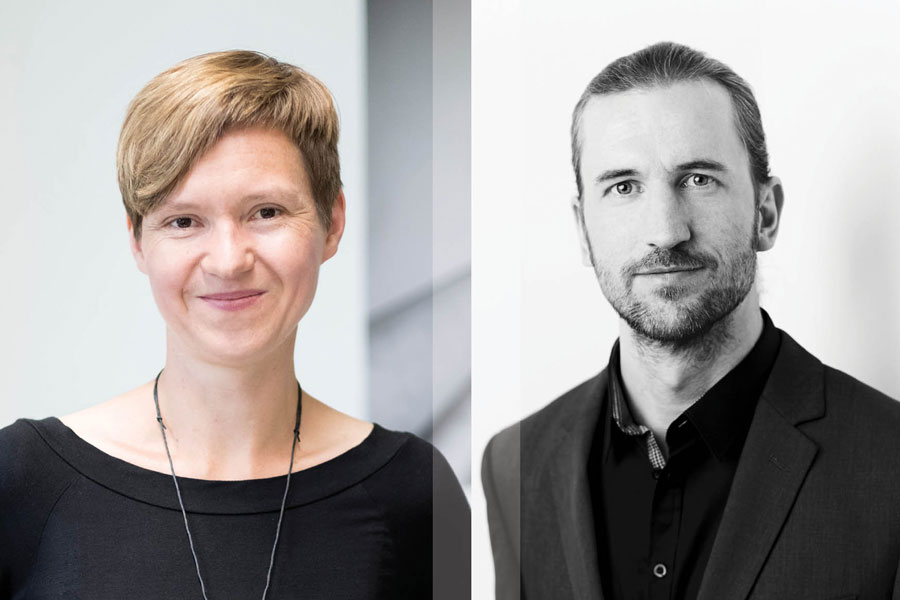ERC Grants for Susanne Schreiber and Martin Rolfs in Berlin
The European Research Council supports three excellent projects at the Humboldt-Universität, two of which are headed by members of the Bernstein Network Computational Neuroscience.

Susanne Schreiber (© Matthias Heyde) and Martin Rolfs Martin Rolfs (© Kopf und Kragen)
/HU Berlin/ BN, Duppé/ Susanne Schreiber, Professor of Theoretical Neurophysiology, and Martin Rolfs, Heisenberg Professor of General Psychology, each receive one of the highly endowed ERC Grants. Both are based at Humboldt University Berlin and are members of the Bernstein Center for Computational Neuroscience in Berlin.
Homoclinic spike generation in cells and networks – AnewSpike
Head of Project: Susanne Schreiber, Computational Neurophysiology
Our thinking and behavior is based on the electrical activity of the nerve cells in our brain. The cells “talk” by means of electrical impulses – also called action potentials. Although the basic biophysical principles of generating electrical impulses are the identical, action potentials can be divided into several classes with specific properties. In the ERC project ANewSpike, a novel type of action potential – which has so far been largely ignored – will be investigated. To this end, the group of Susanne Schreiber, Professor of Theoretical Neurophysiology, will analyze mathematical models of nerve cells.
Specifically, computer simulations and analytical calculations will be used to investigate the effects of so-called “homoclinic” action potentials. These impulses are special because cells with this firing type show the highest sensitivity to incoming signals directly after an electrical impulse, where cells are usually assumed to “listen badly”. As Susanne Schreiber’s team recently demonstrated, this unique property has exciting consequences: minimal changes in temperature or ion concentration can cause a dramatic increase in the synchronization of networks of nerve cells. This means that the cells suddenly begin to oscillate in unison – an effect that usually arises from a modification of the connections between neurons, the latter of which, however, is not required here. The ERC project, therefore, pursues the fascinating hypothesis that this “forgotten” action potential type constitutes a universal mechanism for the onset of normal oscillating brain activity as well as pathological forms of activity, such as during epileptic seizures. By bridging the gap between the nerve cells and the network, the project aims to uncover whether this previously unnoticed type of action potential actually forms an integral part of the dynamics of the healthy and diseased brain.
http://www.neuron-science.de/susanne-schreiber
Susanne Schreiber is Chair of the Bernstein Network Computational Neuroscience and FENS Kavli Scholar.
What structures visual perception? The project VIS-À-VIS
Head of Project: Martin Rolfs, Active Perception and Cognition
A quick glance at the watch or over the shoulder – almost imperceptibly, our eyes are constantly looking for new information. Like lightning-fast cameras, they provide us with every detail of the visual world. So-called visual actions coordinate our eyes, head and body so that our retina can record the relevant parts of our environment. What happens in the brain during this process has been a major challenge for scientists for centuries: How can we not experience the movement of the entire scene on the retina every time our eyes move? How does the brain track the drastic yet imperceptible changes in the retinal positions of objects? And how do we manage to perceive movement, which is reflected on the retina, as our own movement instead of the movement of the world around us?
The project VIS-À-VIS investigates our ability to move as a key component of visual perception. Martin Rolfs, Heisenberg Professor of General Psychology – Active Perception and Cognition, pursues the idea that visual actions support the core functions of active vision. To characterize the systematics of visual actions, he combines innovative technologies and state-of-the-art psychophysical tools. With his interdisciplinary team, he wants to find out whether the specific laws of our movements fundamentally structure our visual perception of the world.
ERC Grant
The grant is awarded by the European Research Council (ERC) and is one of the highest endowed and most prestigious research grants in Europe. The format of the Consolidator Grants is aimed at excellent scientists and supports projects that develop innovative research approaches or deal with new research questions. The funding is awarded for a period of up to five years and amounts to a maximum of two million euros.




